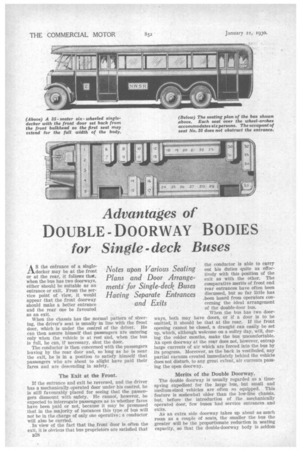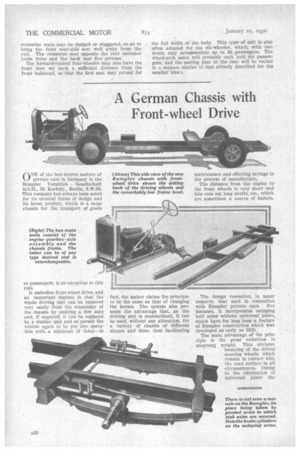Advantages of DOUBLE-DOORWAY BODIES for Single-deck Buses
Page 54

Page 55

Page 56

If you've noticed an error in this article please click here to report it so we can fix it.
A S the entrance of a singlelidecker may be at the front or at the rear, it follows that, when the bus has two doorways, either should be suitable as an entrance or exit. From tile service point of view, it would appear that the front doorway should make a better entrance and the rear one be favoured as an exit.
When the chassis has the normal pattern of steering, the driver's seat is usually in line with the front door, which is under the control of the driver. He can then assure himself that Passengers are entering only when the vehicle is at rest and, when the bus is full, he can, if necessary, shut the door.
The conductor is then concerned with the passengers leaving by the rear door and, so long as he is near the exit, lie is in a position to satisfy himself that passengers who are about to alight have paid their fares and are descending in safety.
The Exit at the Front.
If the entrance and exit be reversed, and the driver has a mechanically operated door under his control, he is still favourably placed for seeing that the passengers dismount with safety. He cannot, however, be expected to interrogate passengers as to whether fares have been paid or not, because it may be presumed that in the majority of instances this type of bus will not be in the charge of only one operative; a conductor will also be carried.
.In view of the fact that the front &or is-often the exit, it is obvious that bus proprietors are satisfied that B28 the conductor is able to carry out his duties -quite as effectively with this position of the exit as with the other. The comparative merits of front and rear entrances have often been discussed, but so far little has .been heard from operators concerning the ideal arrangement of the double-door bus.
When the bus has two doorways, both may have doors, or if a door is to be omitted, it should be that at the rear. If the front opening cannot be closed, a draught can easily be set up, which, although welcome on a sultry day, will, during the colder months, make the bus uncomfortable. An open doorway at the rear does not, however, entrap large currents of air which are forced into the bus by its progress. Moreover, as the back is vestibuled, any partial vacuum created immediately behind the vehicle does not disturb, to any great extent, air currents passing the open doorway.
Merits of the Double Doorway.
The double doorway is usually regarded as a timesaving expedient for the large bus, but small and medium-sized vehicles are often so equipped. This feature is soniewhat older than the low-line chassis, but, before the introduction of the mechanically operated door, few buses had service entrances and exits.
As an extra side doorway takes up about as much room as a couple of seats, the smaller the bus the greater will be the proportionate reduction in seating capacity, so that the double-doorway body is seldom smaller than a 17-seater or 18-seater—a bus which, had it only one dont', would be able to provide accommodation for 20 seated passengers.
A useful type of 20-seater which has a rear entrance and front exit has no door to the entrance, whilst the latter is equipped with a mechanically operated door. The main portion of the saloon will not be more than 10 ft. 6 ins. long and the glazed • portion along each side may be divided into three, the windows being large enough to make the body appear to be of considerable length.
The rear entrance may be of the recessed pattern, that is, with the back framework and panelling extending only so far as the back-step riser. Three pairs of facing-forward seats are arranged in front of the wheel-arch, whilst the near-side longitudinal seat oyer the wheelarch accommodates two passengers.
There are two ways in which the remaining six seats may be arranged. Either a lengthwise seat for three passengers may be placed on the off side, with a seat for three across the back, having one end close to the off-side rear corner, or the off-side longitudinal seat may be continued to the back, so that it holds five passengers and the 20th passenger has a separate seat placed at the centre of the back of the body. This facing-forward seat may be of the folding type, then it may be folded, so as to provide extra circulating area.
A 26-seater with two doorways and conventional steering will be about 24 ft. long overall and there will be sufficient overhang beyond the rear axle for good use to be made of the back of the body, although this overhang may not be large enough to allow a back seat to be extended for the full width of the vehicle.
Instead of three rows, as with the 20-seater just mentioned, there will be four rows of crosswise seats in front of the wheel-arch, with a pair of longitudinal seats, each for two passengers, over the wheel-arches.
The remaining portion of the body should be long enough for the following economical arrangement of seating:—On the off side there is first a facing-forward seat for two persons and behind it a back seat for three.
The former seat is approximately opposite the middle of the rear entrance and leaves plenty of space where it is most required, whilst the back seat for three passengers still leaves room for a near-side corner seat, which faces the end of the other back one.
If the rear seat had been made long enough for four, the feet of the end passenger on the near side would be directly In the doorway or landing, whereas by shifting the fourth seat into the corner and turning it to face the off side, this obstruction is obviated.
A popular tyPe of forward-control 32 seater has a front door immediately behind the front bulkhead, against which there is a seat for three pas sengers facing the rear. Then there are four., pairs of crosswise seat s.
The off-side wheelarch seat accommo dates three and the near-side one two persons. This near
side seat is made shorter than the opposite one, in order that the
crosswise seats may be dodged or staggere& so as to bring the front near-side seat well away from the exit. The crosswise seat opposite the rear entrance holds three and the back seat five persons.
The forward-control four-wheeler may also have the front door, set back a sufficient distance from the front bulkhead, so that the first seat may extend for
the full width of the body. This type. of exit is also often adopted for the six-wheeler, which; with two doors, may accommodate up to 36 .passengers. ' The wheel-arch seats will probably each hold six passengers, and the seating plan at the rear will be varied in a manner similar to that already described for the smaller' buses,




















































































































